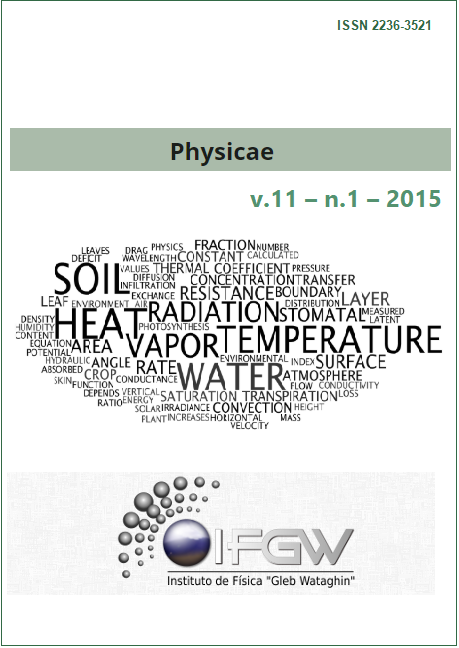Resumo
The horizontal magnetic components observed by ground-based observatories belonging to the INTERMAGNET network have been used to analyze the global pattern of the geomagnetic field variation. The approach is based on the Principal Component Analysis method applied to magnetograms from 2000 to 2005. Quiet and disturbed days were geomagnetically distinguished. The pattern of the geomagnetic field variation fluctuates bewilderingly over time. In this work, we are interested in determining the geomagnetic field variability presenting in each principal component. The results suggest that the oscillation patterns of the first, second and third components could be explained respectively by the first one, two and three terms of the geomagnetic field spherical harmonic expansion. The principal components provide a meaningful way to appraise the overall space-time decomposition of the geomagnetic field.
Referências
W. D. Parkinson, Introduction to Geomagnetism (Scottish Academy Press, 1983) ISBN 9780707302928.
Gonzalez, Journal of Geophysical Research: Space Physics 99, 5771 (1994).
Y. Yamada, Earth, Planets and Space 54, 379 (2002).
M. G. Kivelson and C. T. Russell, Introduction to Space Physics, Cambridge atmospheric and space science series (Cambridge University Press, 1995) ISBN 9780521457149.
O. J. Mendes, A. Mendes da Costa, and M. O. Domingues, Advances in Space Research 35, 812 (2005).
I. A. Daglis and J. U. Kozyra, Journal of atmospheric and solar-terrestrial physics 64, 253 (2002).
L. Sizova, Advances in Space Research 30, 2247 (2002).
O. Pinto Jr. et al., Journal of Atmospheric and Terrestrial Physics 54, 1129 (1992).
M. Nishino et al., Earth, Planets and Space 54, 907 (2002).
O. Pinto Jr and W. D. Gonzalez, Journal of Atmospheric and Terrestrial Physics 51, 351 (1989).
N. B. Trivedi, B. M. Pathan, N. J. Schuch, M. Barreto, and L. G. Dutra, Advances in Space Research 36, 2021 (2005).
A. Mendes da Costa et al., Journal of Atmospheric and Solar-Terrestrial Physics 73, 1478 (2011).
J. D. Horel, Journal of climate and Applied Meteorology 23, 1660 (1984).
C. W. Murray, J. L. Mueller, H. J. Zwally, and Goddard Space Flight Center, Matrix partitioning and EOF/principal compo-nent analysis of Antarctic sea ice brightness temperatures (National Aeronautics and Space Administration, Goddard Space Flight Center Greenbelt, Md, 1984) p. 1 v.
M. A. Oliver and R. Webster, International Journal of Geographical Information Systems 4, 313 (1990).
“International Real-time Magnetic Observatory Network (INTERMAGNET),” (2015), http://www.intermagnet.org.
W. H. Campbell, Quiet Daily Geomagnetic Fields, Pageoph Topical Volumes (U.S. Government Printing Office, 1989) ISBN 9783764323387, pp. 315–331.
“World Data Center for Geomagnetism, Kyoto,” (2015), http://wdc.kugi.kyoto-u.ac.jp/igrf/gggm/index.html.
W. H. Campbell, Introduction to Geomagnetic Fields (Cambridge University Press, 1997) ISBN 9780521529532.
“IGRF-Applet Maps,” (2015), http://www.ava.fmi.fi/MAGN/igrf/.
A publicação é de acesso aberto, sendo os autores responsáveis pelo seu conteúdo. Utiliza-se a licença do Creative Commons para a disseminação da publicação em relação aos direitos autorais.

